
May - June 2003
Vol. 14, No. 3 | Contents
[Excerpt] by Ryan John
... It’s always the USRA’s first major event of each new year, and the 2003 Wilson High School Nationals brought March in like a lion ...
Site
Releases
Results
Recordbook
Mine! Mine!! Mine!!!
Number Crunching
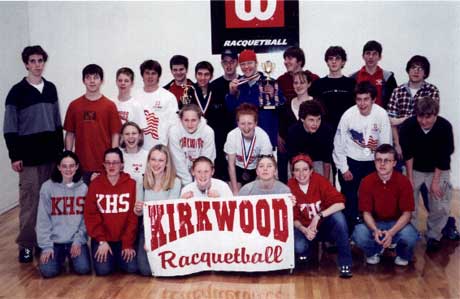 This year Kirkwood High’s team held the distinction of being two-time defending champions, but they were still considered a long shot to win, after losing 25 players to graduation.
This year Kirkwood High’s team held the distinction of being two-time defending champions, but they were still considered a long shot to win, after losing 25 players to graduation.
“It’s going to be hard for us to win again this year,” predicted head coach Michael Von Gerichten. “We are still competitive, but this is really a rebuilding year for us.”
Despite the odds, Kirkwood was able to capture its third straight overall team title by just three points over Catlin Gabel H.S. of Portland, Oregon. “It was a total shock,” assistant coach Paul Gordon said. “I would have bet my house we wouldn’t be in the top five.”
Kirkwood’s win was truly a team effort. Becky and Stephanie Gordon, who each reached the round of 16 in girl’s gold division, and John Donovan, who won the boy’s red division, led them in singles. Clayton Reeves and Mitch Votruba also backed them up with some fine doubles play.
St. Louis University repeated as the boy’s team national champions, led by Phil Mathews and Chris Guilfoy who both made the round of 16 in gold division singles. Mathews then paired up with Tom Carrow to take second in doubles and Guilfoy earned third place in doubles with Mike Brand.
But sometimes having a ringer, or two, can increase a team’s odds. For three-time winner Centerville H.S., it didn’t hurt that their two-girl team was comprised of Adrienne and Kelly Fisher. Adrienne won the girl’s singles and Kelly finished in the quarters. The two then paired to win the girl’s doubles crown, bringing their point earnings to more than enough to clinch another girls’ title.
| Fisher takes Fourth | First for Sheppick |
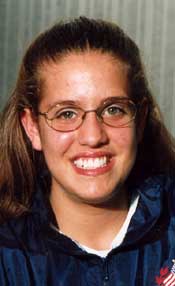 The girl’s draw was large, with 105 players, but most of the talk leading into the tournament was whether or not Adrienne Fisher would capture an unprecedented fourth high school title. Each of the remaining 104 players in the draw was eager to foil Fisher’s attempt to make history. The girl’s draw was large, with 105 players, but most of the talk leading into the tournament was whether or not Adrienne Fisher would capture an unprecedented fourth high school title. Each of the remaining 104 players in the draw was eager to foil Fisher’s attempt to make history.Fisher was the clear-cut favorite in the tournament and received the top seed, followed by last year’s runner-up, Elise Wilson, in the No.2 spot and Adrienne’s younger sister Kelly at No.3. Ashley Willhite, who surprised everyone last year by knocking off Ashley Legget in the quarterfinals, was placed in the No.4 position. All of the top seeds received a bye in the round of 128. As it turned out, that was the only round in which at least one of the top 16 didn’t fall ... [Going into the final] ... Fisher had not allowed an opponent to reach double digits to this point, as she continued to march towards a fourth high school title. That particular scoring run ended after Davis earned 10 in their second game, but Fisher showed that she was still the player to beat by winning 15-7, 15-10. |
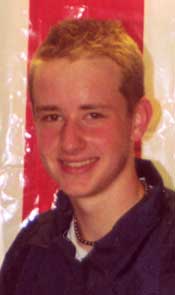 For the second year running, the defending boy’s champion had graduated and left the door open for a new titleholder. For the second year running, the defending boy’s champion had graduated and left the door open for a new titleholder.
Early on, some familiar names began to line up at that door, as 2002 runner-up Dan Sheppick earned the top seed position, followed by No.2 Ben Croft and No.3 Joey Lakowske, all current U.S. Junior Team members. Other team members to claim top spots were No.4 David Chirban, No.5 Charlie Pratt, and No.8 Mike Keddie. [Approaching the final] ... Both Sheppick and Croft had been plowing through the field on a collision course for each other since the first day of play. They were set to square off in a rematch of the 16- junior national final that had taken place last June. Sheppick won that match in a tiebreaker and Croft was out for revenge. The first game was close, with Croft pulling away at the end 15-11. The second game had started out in the same way, and was tied at 2-2, when disaster struck. Going for a ball, Croft rolled over on his ankle. After taking his full 15-minute injury timeout, he attempted to continue the match, but it was easy to see that his mobility was affected, leaving Sheppick to take the second game, 15-8. |
Mine !!
Mine !!!
Historically, siblings have produced some great doubles pairings. Twin sisters Jackie (Paraiso) Rice and Joy (Paraiso) MacKenzie may be the most successful to date, with three national and two world doubles championships to their credit.
At the high school level, several more have paired up to win titles. Linda and Martha Gates teamed up to win the first H.S. girl’s doubles title in 1988; Britt and Alan Engel won the first mixed doubles title in 1991. All in all there have been 18 doubles titles won by siblings, including this year’s girl’s win by Adrienne and Kelly Fisher. Finding a doubles partner that you don’t fight with is hard enough sometimes … RACQUETBALL wanted to know what it was like to play with your brother or sister.
Some thought it was easier… “I think it’s easier because we know each other so well,” said Katie Ferguson, and sister Elizabeth agreed, “It is a lot easier. We don’t have to talk so
much because we kind of know what each other is thinking.”
“I think it’s easier because I know her game better than I would know somebody else that I was just paired up with,” said Kelly Fisher, who teamed up with sister Adrienne to win their third H.S. doubles title. “Because we’ve played together so much and I have watched so many of her matches I know her game better than anyone else.”
Some thought it was harder… “I think it’s harder because I don’t have a problem yelling at her,” said Jeremy Gogel of his sister Emily. “If I was playing with a different doubles partner I would probably be able to restrain myself, but I have no problem yelling at her if she does something wrong and she doesn’t have a problem yelling at me either.”
 Becky and Stephanie Gordon [pictured] agreed, but for different reasons. “I think it’s harder because we play so much alike that we don’t really complement each other,” said Becky. “We have the same strengths and weaknesses.”
Becky and Stephanie Gordon [pictured] agreed, but for different reasons. “I think it’s harder because we play so much alike that we don’t really complement each other,” said Becky. “We have the same strengths and weaknesses.”
“The majority of the time it’s harder,” added Stephanie. “You are harder on the person when they mess up because you know what level they are capable of playing at.”
Whether they thought it was easier or harder, all of the players agreed that it was a fun and unique experience to play with a sibling, and that it has its ups and downs. But the pros must outweigh the cons, because almost one-third of the high school national doubles champions have been made up of sibling teams.
|
High School Team *Numbers are tallied for total team earnings, not for individual ranking points. Top finishers earn standard ranking points. |
With nearly 300 players representing over 50 high schools across the country, tallying team points at the high school nationals could have been a nightmare. Then stepped in computer consultant Rod Anderson, who first became involved in racquetball when his oldest son Ryan began playing 12 years ago. He’s continued to help out in the Oregon area, while his son Jared currently plays on the Sprague H.S. team.
Rod had heard that keeping track of team points was often a problem, so he decided to write a program that would work with the Tournament Management System (TMS) that the USRA uses to run its national events. “There is a report that you can get off of TMS called ‘Daily Results’,” Anderson explained. “It gives a file of every match played that day. I simply pull that information into an application that I made.”
His application tallies each winner’s points and groups them with their team. Only the top four boy’s and girl’s singles and one doubles team from boy’s, girl’s, and mixed can count towards a team’s total. Players receive 12 points for a gold division win, 3 points for a blue, 2 points for a red, and 1 point for a white. Players receive no points for a loss.
Anderson did run into some challenges. “The point totals had to be separated for boy’s teams and girl’s teams,” he said. “Another tricky little thing was that teams had to have at least one boy and one girl to be considered for the overall team title.”
“His program was great,” said Jim Hiser, tournament director. “We were stretched, staff wise, at the tournament desk and Rod really saved us a lot of time.”
Luckily, Anderson also attended the U.S. Intercollegiate Championships in April to watch his older son Ryan compete, and again helped out with the point totals, even though they are calculated a little differently. “I’ll have to tweak the current application to fit the intercollegiate scoring system, which is different.”
The team format of both the high school and intercollegiate nationals guarantee that his work is greatly appreciated by administrators.
Top | RacquetballMagazine.com | USRA.org
© United States Racquetball Association -- All Rights Reserved
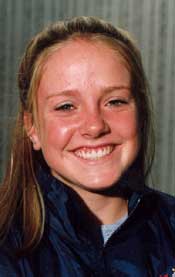 Fuller left the crowd buzzing after knocking off Fisher in the first game 15-11. “I felt like I played awesome,” she explained. “I knew that I had to play tough just to stay with her.”
Fisher agreed, “Jesi was playing really well all week and she came out playing really well in our match.”
Fuller left the crowd buzzing after knocking off Fisher in the first game 15-11. “I felt like I played awesome,” she explained. “I knew that I had to play tough just to stay with her.”
Fisher agreed, “Jesi was playing really well all week and she came out playing really well in our match.”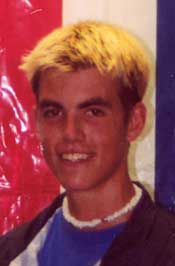 Croft was understandably disappointed. “I had some tough matches before Dan and I knew he was going to be the toughest,” he said. “I was ready for him. It’s just unfortunate that the injury happened.” At the hospital for follow-up treatment, it was later learned that Ben had torn the ligaments in the ankle.
Croft was understandably disappointed. “I had some tough matches before Dan and I knew he was going to be the toughest,” he said. “I was ready for him. It’s just unfortunate that the injury happened.” At the hospital for follow-up treatment, it was later learned that Ben had torn the ligaments in the ankle.